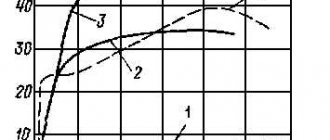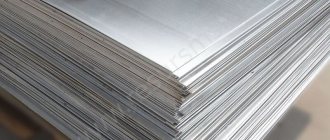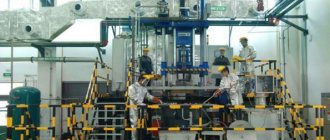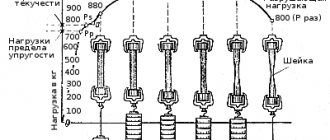Aluminum and aluminum alloys
Aluminum as a structural material is rarely used in its pure form.
Small amounts (sometimes less than 1%) of other elements can significantly change its properties, physical and mechanical. One of the main properties of structural metals is their strength. Unalloyed aluminum has a tensile strength of about 90 MPa. Due to strain hardening (hardening), this value can increase to 200 MPa. However, the addition of small amounts of zinc, copper and magnesium to pure aluminum makes it a high-strength aluminum alloy with a tensile strength of more than 550 MPa. Aluminum alloys are divided into two categories: wrought and cast. Wrought alloys are processed into a given shape by deformation (extrusion, rolling, forging, stamping, drawing). Casting alloys are poured into casting molds.
Thermal and strain hardening
The properties of an aluminum alloy depend not only on its chemical composition, but also on the history of its thermal and deformation treatments.
Wrought aluminum alloys, the strength of which can be increased by heat treatment, are called heat-hardenable alloys. These alloys include all alloys of the 2xxx, 6xxx and 7xxx series. Sometimes deformation treatment is also applied to these alloys, both before and after heat treatment.
Aluminum alloys of the 1xxx, 3xxx and 5xxx series are not able to increase their strength under the influence of heat treatment. Their strength properties are increased by deformation treatment (hardening).
Most cast aluminum alloys are heat hardenable. Cast aluminum alloys are usually not subjected to cold hardening due to their low ductility.
Provider
Sheet 6060 is available in thicknesses from 0.5 mm to 10 mm inclusive. The most common sheets are 1200 mm - 1500 mm wide and 3 - 4 meters long. Semi-finished products of any parameters are supplied to order. All products are certified. Quality is guaranteed by strict adherence to production technology. If necessary, you will receive comprehensive advice. Availability of goods and prompt delivery are ensured by representative offices located in Moscow, St. Petersburg, and cities of Eastern Europe.
Conditions of aluminum alloys
The level of mechanical properties of any aluminum alloy is determined by two main factors:
- the chemical composition of the alloy, that is, the percentage content of both alloying elements and impurities;
- the state of the alloy, that is, the treatment that the alloy received during the manufacturing process of the finished aluminum product, deformation and thermal.
For conditions that are achieved mainly by heat treatment, the designation consists of a capital letter T and one or more numbers, for example, T66.
For states that are achieved by deformation processing, designations are used that consist of the capital letter H and one or more numbers, for example, H14.
Finished aluminum product: alloy + condition
When specifying an aluminum alloy as a structural material, it is necessary to indicate both the designation of the aluminum alloy and the state it received in the finished product, for example, in an extruded aluminum profile. Specifying only aluminum alloy for construction material without specifying the condition does not make sense.
In domestic standards, European and American standards, various forms of joint designation of alloy and state are used: continuous, separated by a space, and separated by a hyphen.
For example, in the currently valid GOST 22233-2001, for profiles made of AD31 alloy, the designation “AD31T1” is used (there is no space between the designation of the alloy and the designation of the condition). This means that the AD31 aluminum alloy profile was subjected to complete hardening and artificial aging.
For profiles made from foreign aluminum alloys 6060 and 6063, the designations of the alloy and condition are used, which are accepted in European standards, that is, separated by a space, for example, 6060 T6. This also means that the 6060 alloy profile has been fully hardened and artificially aged.
In American technical literature and American regulatory documents, the alloy and condition are written with a hyphen (not a dash!), for example, 6063-T6.
Modifications
Aluminum alloy 6063A
- 0.15-0.35% Fe; 0.30-0.6% Si; 0.6-0.9% Mg
- Strength properties are slightly higher than those of alloy 6063 (by 15-25 MPa for T6 condition) without reducing the quality of anodizing
Aluminum alloy 6463
- 0.15% Fe; 0.20% Cu
- Strength properties are slightly lower than those of alloy 6063
- Used to obtain a shiny anodized surface.
Sources: 1) Aluminum and Aluminum Alloys, ed. JR Davis 2) EN 573-3 3) EN 755-2
In the Directory of wrought alloys
See also: Alloy AD31 and its foreign analogues Aluminum profiles from alloy AD31 (6063) Aluminum alloys 6060, 6063 and AD31
Aluminum alloys for aluminum profiles
Russian SP 128.13330.2012 (updated SNiP 2.03.06-85) prescribes the following deformable aluminum alloys for use in building aluminum profiles: AD31, 6060, 6063, AD33, AB, 1915, 1925, V95.
Eurocode 9 uses alloys 5083, 5454, 5754, 6060, 6061, 6063, 6005A, 6106, 6082, 7020 for aluminum profiles.
Russian SP 128.13330.2012 and European Eurocode 9 “intersect” on alloys 6060, 6063, AD33 (6082) and, partially, on alloys 1915 and 1925 (7020).
Note that Eurocode 9 does not use high-strength alloys such as 7075 (analogous to alloy B95). In addition, Eurocode recommends three alloys of the Al-Mg series (5xxx) for aluminum profiles. SP 128.13330.2012 does not contain such alloys for profiles.
Technological properties
Compressibility
Compressibility of alloy 6060 compared to other alloys of the 6xxx series [4]
Weldability
- It is well welded by inert gas arc welding, in particular, by argon-arc welding, both with a non-consumable electrode (GTAW-TIG) and a consumable electrode (GMWA-MIG).
- Common welding alloy is 4043.
Homogenization
580-585 °C for at least 2 hours.
Annealing
420 °C.
Quenching temperature
510 °C.
Artificial aging
185 °C for 5 hours.
Alloys for profiles of enclosing structures
Profiles for building envelopes - windows, doors, facades - are distinguished by a complex cross-sectional shape, including rather thin walls and shelves, grooves for seals and thermal inserts. In addition, these profiles require increased accuracy of cross-sectional dimensions, as well as shape, transverse and longitudinal. Therefore, only aluminum alloys 6060 and 6063 (AD31) are usually used for their manufacture.
The content of the main alloying elements of these alloys - magnesium and silicon - is shown in Figure 1. For comparison, other alloys of the 6xxx series are shown - medium alloyed alloy 6005 and highly alloyed alloys 6061 and 6082.
Figure 1 – Magnesium and silicon in alloys of the 6xxx series
The main advantages of aluminum alloys of the 6060, 6063 and AD31 series are that they are easily pressed and can be fully hardened directly on the press to achieve the maximum strength T6 state using only air cooling.
Three stages of thermal hardening on a press
In conventional heat hardening on a press, 6063 aluminum alloy obtains its full strength - T6 condition - during a three-stage heat hardening process (Figure 1): 1st stage : dissolution of Mg2Si particles in the workpiece before exiting the matrix; 2nd stage : hardening on a press - fixation of dissolved magnesium and silicon in a solid solution; 3rd stage : artificial aging – uniform release of the smallest Mg2Si particles in the volume of the profile.
Figure 1 – Three stages of thermal hardening of aluminum profiles on a press
The role of magnesium and silicon in alloys of the 6xxx series
Magnesium and silicon are the main alloying elements in all 6xxx series aluminum alloys. Magnesium and silicon are included in the compound magnesium silicide (Mg2Si) in a ratio of 1.73 to 1 (Figure 1). It is magnesium silicide that makes 6xxx aluminum alloys thermally hardenable. The level of strength properties of these aluminum alloys depends mainly on the number, size and uniformity of distribution of Mg2Si clusters or particles in aluminum.
Based on the magnesium content in the alloy, the amount of silicon that it will “bind” in magnesium silicide is determined: %Si = %Mg/1.73. For example, if the magnesium content in the alloy is 0.45%, then 0.45/1.73 = 0.26% silicon is required to form magnesium silicide. Part of the silicon is associated with iron and manganese in the primary Al(FeMn)Si particles, which are formed during the casting of the pillars. This amount of silicon is estimated as a third or a quarter of the total content of iron and manganese: 1/4 (Fe + Mn). The rest of the silicon is excess.
Stage 2 – hardening on a press
The second stage requires cooling the hot pressed material coming out of the matrix quickly enough to a temperature close to room temperature. This is necessary to retain all dissolved magnesium silicide (Mg2Si) in the solid solution of the cooled profile. The required cooling rate is proportional to the amount of Mg2Si contained in the 6xxx series alloy.
For alloy 6063 (AD31), which contains 0.8% Mg2Si, the cooling rate in the temperature range from 450 to 200 °C should be at least 50-60 °C per minute. For alloy 6061 (AD33) containing 1.4% Mg2Si, the cooling rate in the same temperature range must be at least 550 °C.
This means that a profile made of alloy 6063 can cool to a temperature of 200 ° C within 4-5 minutes, and for a profile made of alloy 6061 (AD33) this should happen in 25-30 seconds.
The importance of cooling rate after pressing is explained as follows. At the exit from the matrix, all magnesium silicide is dissolved in aluminum. In the critical temperature range from 450 to 200 °C, this aluminum exhibits a strong tendency to uncontrolled release of Mg2Si particles. If such a separation occurs, then it completely eliminates the possibility of complete hardening on the press. This tendency to precipitate is usually referred to as “quench sensitivity” and is mainly dependent on the Mg2Si content.
Figure 3 schematically shows the entire process of thermal hardening with quenching on a press of aluminum alloy 6063 (AD31), including the essence of quenching sensitivity.
Figure 3 – Scheme of thermal hardening with quenching on a press of alloy 6063 (AD31)
The area to the left of the Mg2Si precipitation front shows that all Mg2Si particles are dissolved in aluminum. The area to the right of this serves to indicate the relative sizes and intensities of the Mg2Si particles released.
A pressed profile that receives complete hardening on a press - undergoes cooling, for example, along a dotted line, receives the T1 or T4 state according to the international classification. In this state, the profile is very plastic and can be subjected, for example, to bending to small radii.
Aluminum alloy 6060
- Has a minimum magnesium content of 0.35%, and silicon - 0.30%
- "Diluted" version of alloy 6063
- In T6 condition it provides pressed profiles (up to 3 mm thick) with a minimum strength of 190 MPa
- Easily pressed even with very complex profile cross-sections.
- It is well shaped, for example, flexible, in T4 condition - after hardening and natural aging.
- They are used in windows, doors, facades, as well as in the manufacture of handrails, fences, furniture, and sports equipment.
- Well suited for anodizing – protective and decorative.
Aluminum alloys 6063 and AD31
- The minimum content of magnesium is 0.45%, and silicon - 0.20%
- The increased minimum of magnesium provides higher strength than alloy 6060: in T6 condition - up to 215 MPa
- The increased magnesium content reduces the pressing speed: by 15-20% compared to alloy 6060
- The scope of application is the same as that of alloy 6060, except for complex and thin-walled profiles, when it is recommended to use alloy 6060.
Typical Application
- Enclosing building structures such as windows, facade structures, store entrances, winter gardens.
- Internal partitions, stairs, fences, handrails.
- Heat dissipating elements (“combs”) of electronic devices, including computers.
- Flexible assembly systems, elements of mechanical engineering equipment.
- Truck body parts.
- Internal equipment of passenger cars.
- Irrigation, heating and cooling pipes.
- Furniture and office equipment.
Aging of aluminum alloys: natural and artificial
Typically, natural aging begins immediately after hardening at a relatively high rate, which then gradually decreases (Figure 2). Depending on the alloy, it may take several weeks to reach the T4 state, such as for alloy 6060 with a minimum of magnesium and silicon content. For alloy 6063, which has the highest magnesium and silicon content, this process is virtually complete within about a week.
Figure 2 – Aging of aluminum alloys (not to scale) [3]
Some time after hardening - several hours or days, depending on the alloy and production conditions - the profiles that must be artificially aged are placed in an aging oven. A typical artificial aging regime for profiles made of alloy 6060 is heating to a temperature of 180 ºC and holding for 5 hours to achieve T6, as well as T5 or T66 conditions. At the same time, they try to get to the maximum strength on the aging curve.
With longer aging, the strength of the profiles decreases and then the result is overaged
condition T7.
This condition provides increased electrical conductivity. With a shorter exposure, the material receives an under-aged
state, for example, T64.
Mechanical properties
Standardized mechanical properties
Table 2 - EN 755-2:2016 requirements for mechanical properties of extruded bars, pipes and profiles made of alloy 6060
Typical mechanical properties
See table 2:
- tensile strength
- yield strength (0.2%)
- elongation (A)
- shear strength
- Vickers hardness
Table 2 - Typical mechanical properties of alloy 6060 [1]
Poisson's ratio
0,33
Modulus of elasticity (Young's modulus)
- in tension and compression – 69000 MPa
- in shear – 26000 MPa.
Conditions of profiles made of alloys 6060, 6063 and AD31
The state of the aluminum alloy reflects the processing history of the material of the aluminum product or semi-finished product (deformation and/or thermal). The chemical composition of the alloy and its condition uniquely determine the structure of the material and its mechanical properties.
GOST 22233-2001 applies the following conditions for the AD31 alloy:
- T – hardened and naturally aged;
- T1 – hardened and artificially aged;
- T5 – not completely hardened and artificially aged;
- T1(22) and T1(25) – hardened and artificially aged with increased strength.
For international alloys 6060 and 6063, the following conditions apply:
- T4 – hardened and naturally aged;
- T6 – hardened and artificially aged;
- T5 – not completely hardened and artificially aged;
- T64 - hardened and artificially aged (underaged);
- T66 - hardened and artificially aged with increased strength.
Condition T5
Incomplete hardening of profiles can occur in the following cases:
- when hardening on a press from a temperature below the temperature of complete dissolution of alloying elements;
- if the cooling rate of the profile at the exit from the press is not high enough;
- for “gentle” cooling of thin-walled or complex profiles to prevent their warping.
Conditions T4 and T6
Formally, conditions T4 and T6 include quenching from a separate furnace heating. However, in practice, these states are obtained by hardening on a press. In this case, unlike the T5 state, the temperature of the profiles at the exit from the matrix and the cooling rate of the profiles must be monitored.
Condition T66
Condition T66 is a T6 condition with increased strength properties. These improved mechanical properties are achieved through special measures, for example, more stringent control of the cooling rate of the profiles or a narrower range of alloy chemical composition.
Stage 1 – dissolution of Mg2Si particles in aluminum
The first stage of thermal hardening requires such temperature-time pressing conditions that ensure complete dissolution of all Mg2Si particles in the aluminum solid solution at the moment the profile leaves the matrix.
This can be achieved on a press in two ways: 1) Heating the workpiece to a temperature of at least 500 ºС and exiting the profile from the matrix at a temperature of at least 500 ºС. 2) Heating the workpiece to a temperature of 430-455 ºС and pressing at high speed to obtain a profile temperature at the exit from the matrix of at least 500 ºС (Figure 2).
Figure 2 – Alloy 6063 extrusion conditions for optimal combination of performance, strength and surface finish
The second option gives higher productivity without damaging the surface of the extruded profile. To fully use this option you need to have:
- sufficient force on the press stamp;
- sufficiently high pressing speed;
- a fairly high pressing ratio (draw);
- properly homogenized workpiece;
- the ability to heat the workpiece to a temperature of 425-455 °C in less than 20 minutes.
Prolonged heating of the workpiece, especially in the temperature range of 260-425 °C, leads to a loss of strength of the future profile due to the enlargement of Mg2Si particles, if the workpiece is not then heated to at least 500 °C before pressing.











